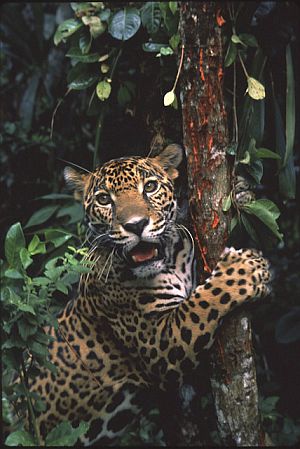Puerto Vallarta, Mexico - Last month, two night watchmen at the Vallarta Botanical Garden reported hearing deep, powerful grunts from the forest and then looking up to a large pair of eyes. Could this have been a jaguar? Probably, and nature lovers and conservationists certainly hope so!
Prior to the rapid development of Puerto Vallarta and surrounding areas, which began accelerating in the 1960's, this entire region was part of a nearly unbroken swath of forest connecting large and healthy populations of jaguars from Mexico to South America. Now, between urban sprawl, destruction of forests to advance agriculture and grazing, and other threats to wilderness areas and their inhabitants, jaguars throughout the Americas face a precarious future.
Fortunately for humans, jaguars, unlike the rest of the world's big cats, do not have an evolutionary history involving primates on the menu as an important food source. Those jaguars that have survived many generations of aggressive hunting by humans have learned to stay away from mankind and to avoid confrontations that could lead to their own demise.
 |
The Vallarta Botanical Garden's nature reserve is part of a belt of forest straddling the Los Horcones River leading from Boca de Tomatlán up towards some of the highest mountains of our region. Jaguars use these kinds of river canyons as corridors to connect their hunting grounds and to find mates during breeding season.
Most of the time, their presence goes completely undetected and it is extremely rare for this to ever pose a threat to humans. Still, reports of jaguar presence in an area are best addressed by monitoring them when possible. Such monitoring has become very accessible in recent years by technological advances in motion detecting camera traps.
This kind of monitoring work is well-coordinated throughout much of the world by wildlife conservation organizations working in conjunction with government agencies and local communities. Foremost in these efforts across the planet is Panthera, the only global nonprofit specifically dedicated to the conservation of big cats in the wild.
Panthera works with lions and leopards in Africa, tigers and snow leopards in Asia, and jaguars and pumas here in the Americas. Their jaguar program is specifically dedicated to ensuring a healthy future for jaguar populations and jaguar corridors from northern Mexico all the way south to Argentina.
Diana Friedeberg, Mexico Country Director for Panthera's Jaguar Program will be working with Garden staff and volunteers in August to install, maintain, and collect images and data from the traps. Images will likely include an abundance of local fauna which, with patience and some luck, will hopefully include an occasional jaguar. This could help inform nationwide jaguar conservation initiatives and would be shared with Mexican governmental agencies charged with protecting our flora and fauna.
Educating the Public
On Saturday, August 11, the Vallarta Botanical Garden hosted a press conference that was open to everyone interested in learning more about jaguars, the largest native cat in our hemisphere.
The meeting took place at their new Old Town PV business office, located at 399 Ignacio L. Vallarta, Local A, near the intersection with Basilio Badillo, where representatives from the Vallarta Botanical Garden, Panthera, and the local NGO Alianza Jaguar (based out of San Pancho, Nayarit) shared information about their work to protect the future of the jaguar here in the mountains surrounding Puerto Vallarta. ¡Viva el jaguar, viva México!

Visit the internationally famous Vallarta Botanical Garden located just 30 minutes south of Old Town at Km. 24 on Highway 200 and easily accessible by public transportation and taxi. This 64 acre wildlife preserve and botanical garden have something fun for everyone. See plantings of vanilla, chocolate, and hundreds of other botanical delights, and don't forget to bring your swimsuit for a refreshing dip in the jungle river. The Garden is open daily from 9:00 am to 6:00 pm (closed Mondays from April 1 to December 1). Garden admission is just $200 pesos. Authentic Mexican Cuisine is served in the Hacienda de Oro Restaurant from 10:00 am to 5:00 pm. For more information, call (322) 223-6182 or visit vbgardens.org.
Click HERE to learn more about Vallarta Botanical Gardens.



